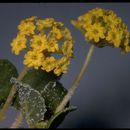Comments
provided by eFloras
S. S. Tillett (1967) considered plants of Abronia umbellata var. minor (Standley) Munz to be introgressants between A. latifolia and A. umbellata.
- license
- cc-by-nc-sa-3.0
- copyright
- Missouri Botanical Garden, 4344 Shaw Boulevard, St. Louis, MO, 63110 USA
Description
provided by eFloras
Plants perennial. Stems prostrate, often buried in sand, usually much branched, forming large mats, succulent, densely glandular-pubescent to glabrous. Leaves: 1-6 cm; blade deltate-ovate to reniform, 2.2-4.8 × 2.7-5.2 cm, margins usually entire, sometimes slightly repand and undulate, surfaces glabrous or viscid-puberulent. Inflorescences: peduncle longer than subtending petiole; bracts ovate, 5-9 × 3-5 mm, thin, yellowish green, glandular-pubescent; flowers 17-35. Perianth: tube yellowish green, 6.5-18 mm, limb yellow, 8-13 mm diam., lobes slightly to moderately reflexed. Fruits winged, ± rhombic in profile, attenuate at both ends, 8-15 × 6-14 mm, scarious; wings 4-5, thin walled, small, cavities extending into wing.
- license
- cc-by-nc-sa-3.0
- copyright
- Missouri Botanical Garden, 4344 Shaw Boulevard, St. Louis, MO, 63110 USA
Distribution
provided by eFloras
B.C.; Calif., Oreg., Wash.
- license
- cc-by-nc-sa-3.0
- copyright
- Missouri Botanical Garden, 4344 Shaw Boulevard, St. Louis, MO, 63110 USA
Habitat
provided by eFloras
Sandy soils, coastal scrub, lees of dunes adjacent to strand; 0-50m.
- license
- cc-by-nc-sa-3.0
- copyright
- Missouri Botanical Garden, 4344 Shaw Boulevard, St. Louis, MO, 63110 USA
Comprehensive Description
provided by North American Flora
Abronia latifolia Eschsch. M£m. Acad. St.-P6tersb. 5: 271. 1826
Abronia avenaria Menzies; Hook. Exot. Fl. pi. 193. 1827. Tricratus arenarius Spreng. Syst. Cur. Post. 53. 1827.
Perennial, from an elongate fleshy root, this 2-10 cm. in diameter and often 30 cm. long or longer; stems very stout, 3-10 dm. long, sparingly branched, prostrate, densely glandularpuberulent, the internodes mostly longer than the leaves; petioles stout, 1-6 cm. long, viscidpuberulent; leaf-blades orbicular to oval, rounded-deltoid, or reniform, 1.5-4 cm. long, 1-4 cm. wide, obtuse to subcordate at the base, sometimes short-decurrent, broadly rounded at the apex, thick and succulent, sparsely or densely and minutely viscid-puberulent, or sometimes glabrate; peduncles stout or slender, 2-10 cm. long, viscid-puberulent or viscidvillous ; bracts 5, broadly ovate or ovate-oval, 5-7 mm. long, 3-4 mm. wide, obtuse or acute, scarious, viscid-puberulent or short-villous; flowers numerous, the perianth 13-15 mm. long, the tube slender, short-villous or viscid-puberulent, greenish-yellow, the limb 5-8 mm. broad, yellow; fruit biturbinate, 8-15 mm. long, deeply 5-lobed, coriaceous, puberulent, 1-costate in the angles, the lobes compressed, winglike, trans verseveined, attenuate upward or subtruncate; seed elliptic-oblong, 4-5 mm. long, brown.
Type locality: California.
Distribution: Sandy seashores, southern British Columbia to Santa Barbara County, California.
- bibliographic citation
- Paul Carpenter Standley. 1918. (CHENOPODIALES); ALLIONIACEAE. North American flora. vol 21(3). New York Botanical Garden, New York, NY
Abronia latifolia: Brief Summary
provided by wikipedia EN
The perennial flower Abronia latifolia or Abronia arenaria is a species of sand-verbena known commonly as the coastal, or yellow sand-verbena. It is native to the west coast of North America, from southern California to the Canada–United States border.
The plant bears attractive neatly rounded heads of small, bright golden flowers. The individual flowers have no petals; rather, they are composed of yellow bracts forming a trumpet-shaped calyx about the stamens. It bears a small, winged fruit. The plant grows in succulent mats on sand or other coastal substrate. The roots are stout, fusiform and often several feet long. These roots are edible, traditionally eaten by the Chinook Indians. This plant is seen exhibiting psammophory, a method by which plants save themselves from herbivores by attracting sand to their body making them difficult to be eaten. It needs salt water, not fresh water, and will not tolerate extreme drought.
- license
- cc-by-sa-3.0
- copyright
- Wikipedia authors and editors

